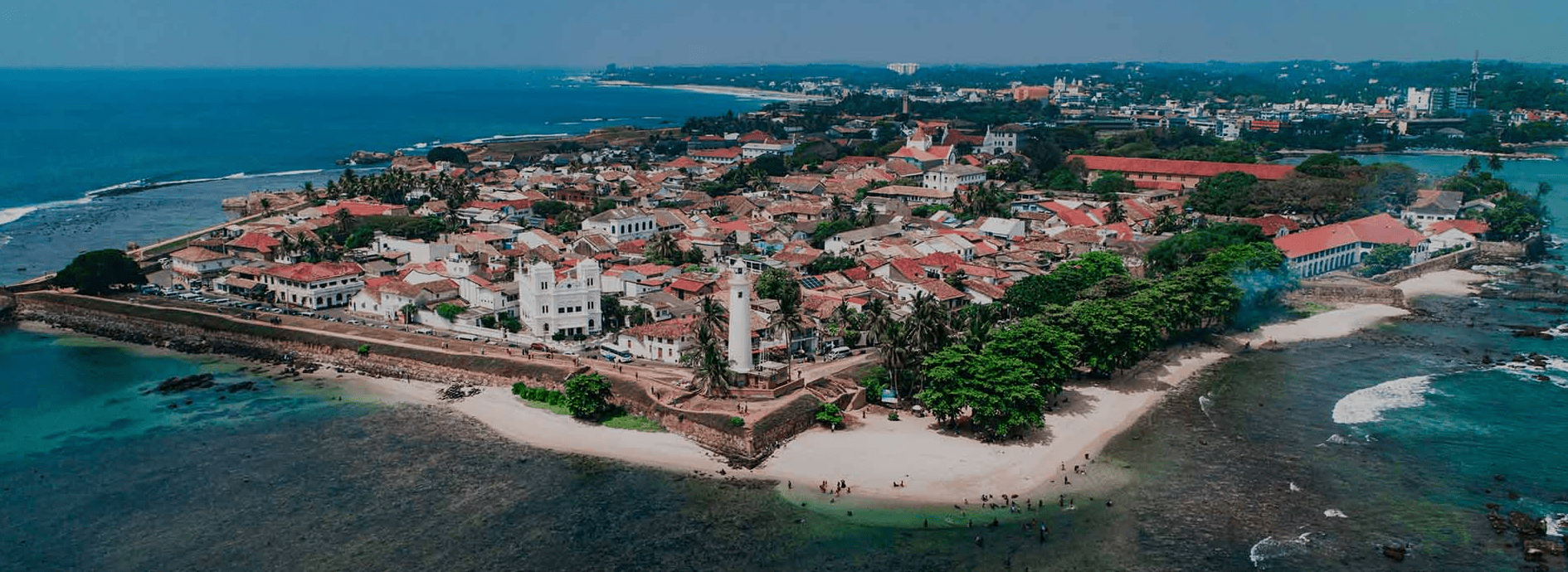Galle (pronounced "Gaulle" as in "Charles de Gaulle") would be described in a travel magazine as an unequalled example of living history. TRAVEL writers are famous for the hype and phrases they use to promote destinations. On rare occasions, the cliches turn out to be true, Galle is one such example. It is located 126 km south of Colombo on the south-western coast of Sri Lanka.
Situated on the main trade route between Europe and Asia, Sri Lanka has been a trading nation for over two thousand years. The natural harbour at Galle formally known as Point de Galle was one of the most prominent ports on the island and an essential port of call for Arab, Chinese, Greek, Indian, Malay, Persian and Roman traders of the ancient world. Since antiquity until the nineteenth century Galle remained an important port for trade where the east met the west and traded with one a another.
Although Galle is no longer a centre for international trade, it continues to attract international visitors in its new role as a tourist destination. The main focus of visitors to the city is Galle Fort, formally known as Fort Santa Cruz. It was initially constructed in 1588 by the Portuguese and much improved in the 17th century by the Dutch. The fort is among several cities in Sri Lanka that have been declared UNESCO World Heritage Sites by the United Nations. Galle Fort is special because it is considered to be the finest remaining example of a European fort in Asia.
When entering the granite walled fort through its giant gates, it feels like walking through a time portal into the era of Vasco Da Gama and the age of discovery. The historic buildings along the cobbled stone streets are of a low rise tropicalised European design. Fort buildings have either been beautifully restored, in the process of being restored or yet to be restored to their former glory.
Unlike many of the castles in Europe, Galle fort is not just there to be photographed, blogged and vlogged by visitors. The fort is a living city populated by a multinational community of residents who call it home. Most of the fort buildings are still in use today. Even centuries old former government buildings such as hospitals and military barracks have been expertly renovated in recent times and re-purposed into commercial spaces. Once the fort is fully restored it will undoubtedly become one of the finest historic cities of the world.
EXPLORE GALLE FORT
Galle Fort is the main tourist attraction of the city. The majority of the buildings that have survived the passage of time are of Dutch origin together with a lesser number of English buildings of more recent construction.
The fort is an oasis of calm where the passage of time seems to slow down and the vibes are distinctly chilled. A leisurely stroll along the historic streets of the fort is the best way to explore it. The fort street names are interesting and very different to those found in other parts of the island. Pedlar Sreet has a number of restaurants, cafes and boutiques that are particularly popular with tourists. There are numerous grand mansions, attractive villas and warehouses that once belonged to wealthy merchants alongside far less opulent family homes of colonial officials, lawyers and doctors that have already been restored and turned into chic boutique hotels. Buddhist, Christian and Muslim places of worship; administrative offices, courts, banks, schools, shops, cafes, jewellers, restaurants, spas, art galleries, museums boutique hotels and even estate agencies that market Galle properties at London prices can also be found within the fort.
A walk along the ramparts is a must, it is the ideal way to get a birds eye view of the fort and its various monuments including the light house and the clock tower. The ramparts are also the best location from which to see the magical sun sets over the clear blue sea.
RETAIL THERAPY
There are no international designer boutiques or duty free shops in Galle, what it does have are products crafted by local people. A range of rustic and trendy boutiques sell traditionally made clothing, toys, jewellery and souvenirs.
Sri Lanka is world famous for its gems and precious stones, it is the place where Ceylon Sapphires come from. The blue gemstone used to make the engagement ring for Princess Diana which is now worn by the Duchess of Cambridge is a Ceylon Sapphire from Sri Lanka. The fort is home to several jewellery stores where some of Sri Lanka gems and jewellery is on display for visitors to see.
MUSEUMS
National Museum of Galle
The National Museum of Galle is located in the oldest remaining Dutch building in the fort. It was constructed in 1656 as a store for Dutch troops, then re-purposed as a billiard room and opened to the public as a museum after being renovated in 1985. It is situated adjacent to the former Governors residence which has also been renovated and transformed into a chic boutique hotel.
The museum houses exhibits from the Portuguese, Dutch and British periods in three galleries. The first contains collections relating to the area's cottage industries, the second contains a collection of Dutch period artifacts including furniture and weapons while the third gallery contains exhibits relating to trade relations that existed with China since ancient times.
National Maritime Archaeology Museum
Galle was for several centuries the most important harbour on the island. This means apart from the ships that came and went a certain number have also sunk in around the port over the years. The National Maritime Archaeology Museum in the fort contains many of the artifacts that were recovered from ship wreaks from Galle harbour dating back over 800 years. Maps, weapons, pottery and artillery pieces are among the exhibits
The collection seen today is a fraction of the what it was, a large percentage of the artifacts were lost or damaged during the Boxing Day tsunami of 2004. Nevertheless, the Museum is still worth a visit.
BUDDHIST TEMPLES, CHURCHES & MOSQUES
Sri Sudharmalaya Buddhist Temple
The Buddhist temple was constructed in 1889 on land that was gifted to the Buddhist clergy by a wealthy Sri Lankan Buddhist Philanthropist who lived in the fort during the Victorian period. The temple over looks the lawn and ramparts of the fort. The white washed temple complex consist of a compact stupa, statue of the reclining Buddha, a temple hall and a bell tower.
Dutch Reformed Church
It is believed that the church was initially constructed in 1640 and was made bigger and better in the first half of the 1700s. It is equipped with an antique organ that is believed to be the oldest of its kind still in existence east of Suez. The church floor is paved with grave stones and rumour has it that human remains of former fort residents have been buried under the floor and within the walls of the church.
All Saints Church
All Saints Church is an Anglican church located within the fort. It was completed in 1871 on the site of a Portuguese or Dutch court complex that was probably demolished when a new court complex was built on a alternative location in nearby Hospital Street.
All Saints was designed by the Ceylon government architect in the Victorian Gothic Revival style popular during the period. It incorporates modifications to suit the tropical climate of Galle.
Fort Mosque - Meeran Jumma Masjid
Meeran Masjid or mosque in Arabic is thought to have been around for a long time to cater to the Arab traders and their families. It was reconstructed during the Victorian period and appear to have a blend of European and Arabic architectural styles. It is the best known mosque in the Galle area.
CRICKET
From the ramparts of the fort the test cricket grounds in Galle can be seen clearly. It is probably the worlds only cricket ground built so near to the ocean in the shadow of a military fort.
Test match tickets are relatively inexpensive compared to prices in England. Galle probably offers fans the only opportunity in the world to watch England play a test match under perfect conditions, uninterrupted by rain to the gentle sound of ocean waves in the background. Howzat, for your money's worth!
FOOD
The fort is probably the best place to dine out in Sri Lanka outside of Colombo. Whether its for breakfast, lunch, afternoon tea or dinner, there are plenty of places to choose from to suit all tastes and all budgets.
There are restaurants that dish up both western and eastern cuisine, along with some cafes that even serve authentic Italian gelato made by Italians within Galle Fort. Being bordered by the ocean on one side and fertile tropical agricultural land on the land side, fresh fruits, vegetables and sea food can be found in abundance. So the food in Galle can only be described as delicious.
For those who want some genuine American fast food, that too is available in Galle and all such establishments can be found outside the historic walls of the fort.
There are two ways to explore Galle. The best way is to stay in the fort, see the sites and take in the historic vibes. The beach at Unawatuna is also nearby and easily accessible from Galle.
Staying in Galle fort is an experience, it is all about the ambiance and the feeling of being transported back to the time of the renaissance and the age of the great explores. The best places to stay are the boutique hotels within the fort. The boutique hotels are all period buildings that have been restored and brought back to life in recent times. The accommodation in the fort is not cheap but the extra cost is definitely worth it.
There is a less expensive option too, that is to stay at nearby Unawatuna, Mirissa or Weligama and go on a day trip to Galle, the city can easily be explored in a day. However, a day is simply not enough time to fully absorb the vibe of the place.
Galle is like Dubrovnik but with a much longer and exotic history. As a well preserved and inhabited city with a European history, it is a one of a kind destination in Asia. So for travellers whose interests extend beyond mere sun, sand and sea, Galle is fully worth a visit.

